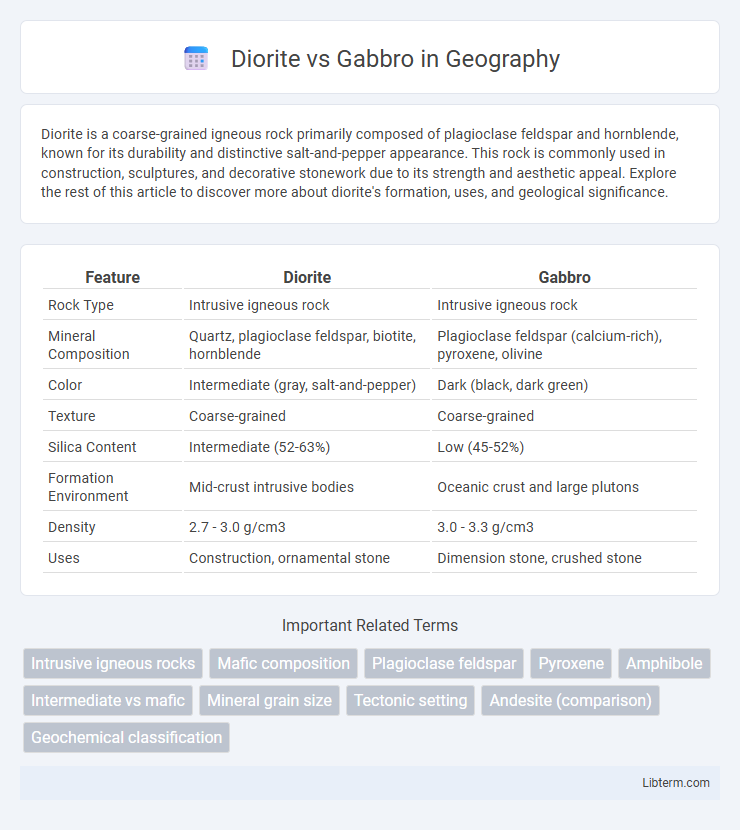Diorite is a coarse-grained igneous rock primarily composed of plagioclase feldspar and hornblende, known for its durability and distinctive salt-and-pepper appearance. This rock is commonly used in construction, sculptures, and decorative stonework due to its strength and aesthetic appeal. Explore the rest of this article to discover more about diorite's formation, uses, and geological significance.
Table of Comparison
| Feature | Diorite | Gabbro |
|---|---|---|
| Rock Type | Intrusive igneous rock | Intrusive igneous rock |
| Mineral Composition | Quartz, plagioclase feldspar, biotite, hornblende | Plagioclase feldspar (calcium-rich), pyroxene, olivine |
| Color | Intermediate (gray, salt-and-pepper) | Dark (black, dark green) |
| Texture | Coarse-grained | Coarse-grained |
| Silica Content | Intermediate (52-63%) | Low (45-52%) |
| Formation Environment | Mid-crust intrusive bodies | Oceanic crust and large plutons |
| Density | 2.7 - 3.0 g/cm3 | 3.0 - 3.3 g/cm3 |
| Uses | Construction, ornamental stone | Dimension stone, crushed stone |
Introduction to Diorite and Gabbro
Diorite and gabbro are coarse-grained intrusive igneous rocks formed from the slow cooling of magma beneath the Earth's surface. Diorite primarily consists of plagioclase feldspar and hornblende, giving it a salt-and-pepper appearance, while gabbro is composed mainly of calcium-rich plagioclase and pyroxene, resulting in a darker, greenish-black color. Both rocks play significant roles in the Earth's crust composition and serve as important materials in construction and geological studies.
Geological Formation Processes
Diorite forms through the slow cooling and crystallization of intermediate magma in intrusive igneous environments, resulting in coarse-grained textures with plagioclase feldspar and hornblende minerals. Gabbro originates from the crystallization of mafic magma, rich in iron and magnesium, under similar intrusive conditions but produces a darker, denser rock dominated by pyroxene and calcium-rich plagioclase. Both rocks crystallize beneath the Earth's surface but differ in mineral composition and magma chemistry, reflecting distinct magmatic differentiation processes.
Mineral Composition Differences
Diorite primarily consists of plagioclase feldspar, typically andesine, along with biotite, hornblende, and minor quartz, giving it a speckled black-and-white appearance. Gabbro is rich in calcium-rich plagioclase feldspar, usually labradorite, and abundant pyroxene, with lesser amounts of olivine and amphibole, resulting in a darker, more mafic texture. The mineral composition difference is key: diorite is intermediate in silica content between felsic granite and mafic gabbro, while gabbro is more mafic and lower in silica.
Texture and Appearance
Diorite features a coarse-grained, phaneritic texture with interlocking feldspar and hornblende crystals, giving it a salt-and-pepper appearance characterized by lighter and darker mineral grains. Gabbro also exhibits a coarse-grained texture but is dominated by plagioclase feldspar and pyroxene, resulting in a darker, more uniform black or dark green coloration. The contrast in mineral composition and crystal size between diorite and gabbro directly influences their distinct textures and overall visual appearance.
Color Variations
Diorite typically exhibits a salt-and-pepper appearance with a mix of light gray to white feldspar and dark black or greenish-black amphiboles, creating a coarse-grained texture. Gabbro, in contrast, tends to display darker colors overall, predominantly deep green, black, or dark gray due to its high content of pyroxene and plagioclase feldspar. These distinct color variations directly relate to their mineral compositions and cooling histories, influencing their identification and use in construction and decorative stone applications.
Common Uses in Industry
Diorite is commonly used as a dimension stone in construction and ornamental applications due to its attractive speckled appearance and durability. Gabbro serves prominently in the construction industry as crushed stone for road base, railroad ballast, and concrete aggregate because of its coarse grain and high density. Both rocks are valued in the manufacturing of countertops and tiles, with gabbro preferred for its darker color and diorite for its lighter, salt-and-pepper pattern.
Global Occurrence and Locations
Diorite predominantly forms in continental crust regions associated with volcanic arcs and mountain-building zones, with significant occurrences in North America's Sierra Nevada and parts of the Scottish Highlands. Gabbro is mainly found in oceanic crust settings, particularly within large igneous provinces and mid-ocean ridges, with notable exposures in the Oman ophiolite and the Troodos massif in Cyprus. Both rock types are integral to understanding tectonic processes but differ significantly in their global distribution due to their formation environments.
Weathering and Durability
Diorite exhibits moderate weathering resistance due to its coarse-grained texture and high feldspar content, which can lead to gradual surface erosion in humid environments. Gabbro, with its denser, mafic composition and lower silica content, demonstrates superior durability and slower weathering rates, making it more suitable for construction exposed to harsh weather. Both rocks resist mechanical weathering well, but gabbro's mineralogy enhances its longevity in chemically aggressive conditions.
Identification in the Field
Diorite and gabbro can be distinguished in the field by their color and mineral composition; diorite typically exhibits a speckled appearance with light gray to white feldspar and darker hornblende or biotite, while gabbro is generally darker, with abundant black pyroxene and plagioclase feldspar. Diorite's texture is coarse-grained, similar to gabbro, but diorite's lighter mineral content and more noticeable white to gray patches contrast with gabbro's uniformly dark, greenish-black to black color. Field identification also relies on diorite's intermediate silica content compared to gabbro's mafic composition, affecting density and hardness, with diorite often feeling slightly less dense and gabbro more massive and heavier.
Summary: Key Differences and Similarities
Diorite and gabbro are both coarse-grained igneous rocks with similar intrusive origins but differ primarily in mineral composition; diorite is rich in plagioclase feldspar and biotite or hornblende, whereas gabbro contains more pyroxene and calcium-rich plagioclase. Both rocks have similar textures and crystallization processes, forming deep within the Earth's crust, but gabbro is typically darker and denser due to its higher mafic mineral content. These differences influence their geological applications and identification in petrology.
Diorite Infographic

 libterm.com
libterm.com